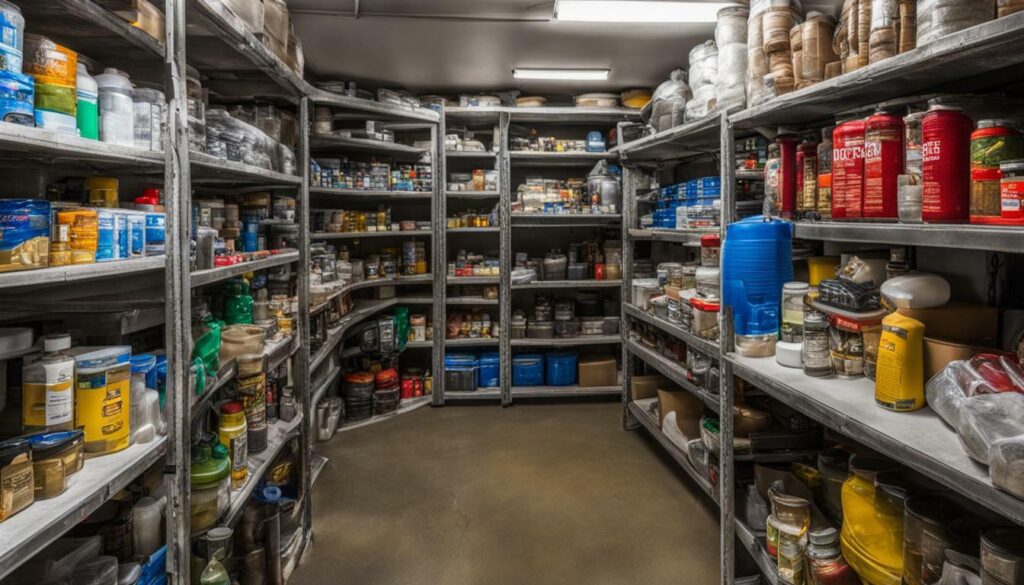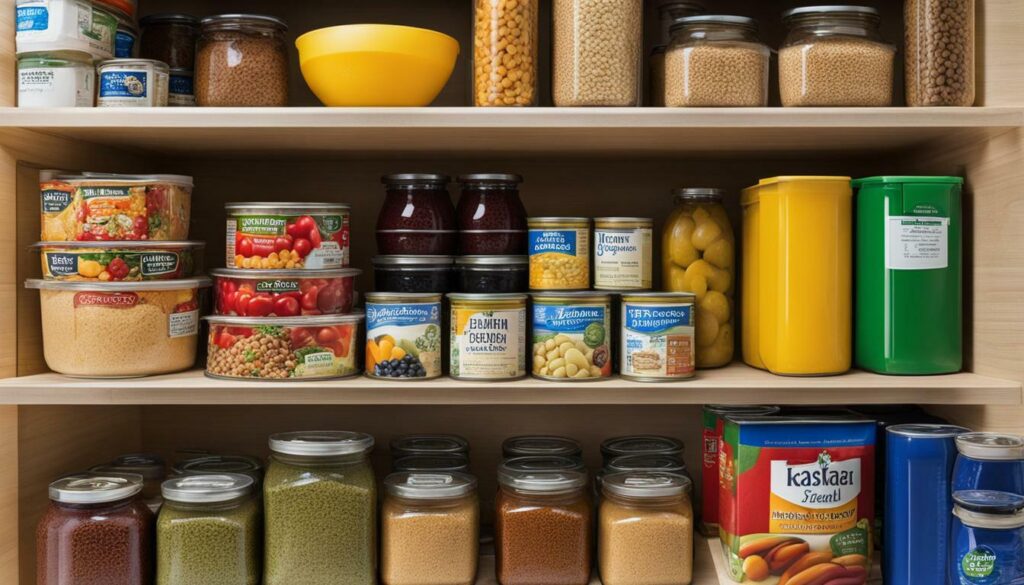Welcome to my guide on how to store cornmeal long term. If you’re a fan of this versatile ingredient and want to ensure its freshness and quality for extended periods, you’re in the right place. In this article, I will share essential cornmeal storage tips to help you preserve your supply effectively. By understanding the factors that affect its shelf life and choosing the right storage containers, you can ensure that your cornmeal stays fresh and flavorful for whenever you need it.
Before we dive into the specifics, let’s take a closer look at cornmeal itself. Cornmeal comes in different types, including fine, medium, coarse, and instant. Each type has its own unique texture and application in various recipes. Understanding the differences between them will enable you to choose the right cornmeal for your culinary creations.
Factors such as moisture content, temperature, light exposure, and oxygen can significantly impact the shelf life of cornmeal. To ensure optimal storage conditions, it’s important to choose airtight containers made of glass or food-grade plastic. Storing cornmeal in a cool, dry place away from direct sunlight and heat sources will help maintain its freshness and quality.
So, if you’re ready to unlock the secrets of long term cornmeal storage, let’s dive in!
Understanding Cornmeal and its Types
Cornmeal, a versatile ingredient made from ground dried corn kernels, comes in various textures and types. Each type of cornmeal has its own unique characteristics, making it suitable for different culinary applications.
Fine Cornmeal:
This type of cornmeal has a powdery texture and is commonly used in baking recipes. It is perfect for making cornbread, muffins, and cakes, providing a smooth consistency and enhancing the overall flavor.
Medium Cornmeal:
With a slightly coarser texture, medium cornmeal adds a delightful graininess to cornbread, pancakes, and waffles. It gives these dishes a rustic appeal while maintaining a tender and moist center.
Coarse Cornmeal:
Coarse cornmeal offers a hearty texture and is ideal for dishes like polenta, tamales, and cornmeal porridge. Its larger grain size gives these dishes a satisfying bite and a more substantial mouthfeel.
Instant Cornmeal:
Instant cornmeal, also known as “quick” or “precooked” cornmeal, has been precooked and dehydrated. It is a convenient option for thickening soups, stews, and gravies. Instant cornmeal dissolves quickly and effortlessly, saving you cooking time while still providing the desired thickness.
Factors Affecting Cornmeal Storage
When it comes to storing cornmeal, several factors can significantly impact its shelf life and overall quality. By understanding these factors and implementing proper storage techniques, you can ensure that your cornmeal remains fresh and flavorful for an extended period. Let’s take a closer look at the key factors affecting cornmeal storage:
Moisture Content
Moisture content plays a crucial role in the storage of cornmeal. Excessive moisture can lead to mold growth, while low moisture levels can result in dryness. To maintain the ideal moisture level, it is essential to store cornmeal in a cool, dry place and use airtight containers that prevent moisture from entering. By doing so, you can preserve the texture and taste of your cornmeal.
Temperature Considerations
Extreme temperature fluctuations can have a significant impact on the flavor and texture of cornmeal. It is important to avoid storing cornmeal in areas exposed to direct sunlight and heat sources, as this can accelerate spoilage. Instead, opt for a cool and dry location, such as a pantry or cupboard, to maintain optimal conditions for your cornmeal.
Light Exposure
Light exposure can degrade the nutritional value and flavor of cornmeal over time. It is recommended to store cornmeal in opaque containers or dark areas to minimize light exposure. By keeping your cornmeal away from direct light, you can preserve its quality and ensure it remains fresh and nutritious.
Oxygen and Its Effect on Cornmeal
Oxygen can cause cornmeal to become rancid, affecting its taste and freshness. To prevent oxidation, it is crucial to store cornmeal in airtight containers. These containers create a barrier that limits the oxygen exposure, thereby preserving the quality and extending the shelf life of your cornmeal.
By considering these factors when storing your cornmeal, you can ensure that it remains in excellent condition for an extended period. Whether you use cornmeal for baking, cooking, or other culinary endeavors, proper storage is key to enjoying its full potential.
Choosing the Right Storage Container
When it comes to storing cornmeal for the long term, choosing the right storage container is of utmost importance. Airtight containers play a crucial role in maintaining the freshness and quality of cornmeal by preventing moisture, oxygen, and pests from compromising its integrity. With the right container, you can ensure that your cornmeal stays fresh and ready to use whenever you need it.
So, what are the suitable materials for cornmeal storage? Glass and food-grade plastic containers are excellent options. These materials provide an airtight seal, preventing any external elements from entering and affecting the cornmeal. Glass containers are especially beneficial as they are non-porous, meaning they won’t absorb any odors or flavors that could alter the taste of your cornmeal. Food-grade plastic containers are another viable choice, providing a lightweight and durable solution for long term storage.
The Importance of Airtight Containers
Using airtight containers not only keeps your cornmeal safe from moisture, oxygen, and pests but also helps to maintain its freshness, flavor, and nutritional value. The airtight seal created by these containers acts as a barrier, preventing any form of contamination that could lead to spoilage. Additionally, keeping out oxygen is crucial, as it can cause cornmeal to become rancid, which negatively impacts its quality and taste.


When storing cornmeal, it’s important to remember that the container itself is as critical as the storage location. By opting for airtight containers made of glass or food-grade plastic, you can ensure that your cornmeal remains fresh and ready to use for an extended period. So, make the right choice and safeguard your cornmeal by investing in the proper storage containers.
Conclusion
After understanding the factors that affect the shelf life of cornmeal, I have discovered effective storage techniques for long-term cornmeal preservation. By carefully considering moisture content, temperature, light exposure, and oxygen, I can ensure that my cornmeal remains fresh and flavorful.
Choosing the right storage container is crucial in maintaining the quality of cornmeal. Airtight containers made of glass or food-grade plastic provide the necessary protection against moisture, oxygen, and pests, preserving the taste, texture, and nutritional value of the cornmeal.
With these practices in place, I can confidently store cornmeal for extended periods, knowing that it will be ready for all my culinary creations. Whether I use fine cornmeal for baking, medium cornmeal for cornbread, or coarse cornmeal for polenta, I can be assured of its top-notch quality.
So remember, to achieve long-term cornmeal preservation, follow these effective cornmeal storage techniques. Your cornmeal will always be at its best, ready to enhance your favorite recipes with its delightful flavor and texture.
FAQ
How should I store cornmeal long term?
To store cornmeal long term, it is important to choose the right storage container, such as airtight containers made of glass or food-grade plastic. Storing cornmeal in a cool, dry place away from direct sunlight and heat sources will help maintain its freshness and quality.
What are the different types of cornmeal?
Cornmeal comes in various textures, including fine, medium, coarse, and instant. Fine cornmeal is suitable for baking recipes, while medium cornmeal works well in cornbread and pancakes. Coarse cornmeal adds a hearty texture to dishes like polenta and tamales. Instant cornmeal, which has been precooked and dehydrated, is a convenient option for thickening soups and stews.
How do factors like moisture content, temperature, light exposure, and oxygen affect cornmeal storage?
Excessive moisture can lead to mold growth, while low moisture levels can result in dryness. Extreme temperatures can affect the flavor and texture of cornmeal. Light exposure can degrade the nutritional value and flavor. Oxygen can cause cornmeal to become rancid.
What type of storage container should I choose for cornmeal?
Airtight containers made of glass or food-grade plastic are suitable for storing cornmeal long term. These materials help maintain freshness, flavor, and nutritional value while protecting cornmeal from external factors.
What are effective cornmeal storage techniques for long term preservation?
To effectively preserve cornmeal long term, store it in a cool, dry place away from direct sunlight and heat sources. Use airtight containers made of glass or food-grade plastic to prevent moisture, oxygen, and pests from compromising the quality of the cornmeal.








